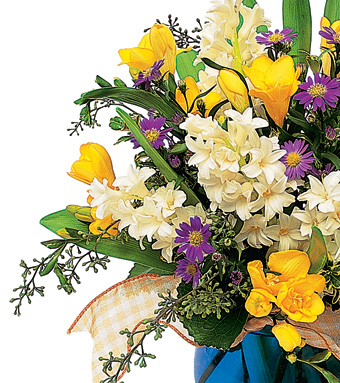 |
 |
|
|
|
|
|

University Research Indicates Flowers and Plants Promote Innovation, IdeasKey Findings Shed Light on Environmental Psychology of the Workplace
According to business experts, the key to gaining the competitive edge in the modern economy is easy to understand - a happy, productive workforce. And, while sometimes the easiest notions can be the most difficult to achieve, a recent scientific study conducted at Texas A&M University finds that nature can hold the secret to business success. The research demonstrates that workers' idea generation, creative performance and problem solving skills improve substantially in workplace environments that include flowers and plants. "Our research shows that a change as simple as adding flowers and plants can be important in the most meaningful way to businesses in the modern economy," said Dr. Roger Ulrich, lead researcher on the project. "People's productivity, in the form of innovation and creative problem solving, improved - which in certain circumstances could mean the difference between mild and great business success." Call Meme’s Florist at 1-866-243-6862 today or simply contact us online! It's easy to make your workplace more attractive, comfortable and productive!Research Findings: Overall and Men vs. WomenIn an eight-month study, the Texas A&M University research team explored the link between flowers and plants and workplace productivity. Participants performed creative problem solving tasks in a variety of common office environments, or conditions. The conditions included a workplace with flowers and plants, a setting with sculpture and an environment with no decorative embellishments. During the study, both women and men demonstrated more innovative thinking, generating more ideas and original solutions to problems in the office environment that included flowers and plants. In these surroundings, men who participated in the study generated 15% more ideas. And, while males generated a greater abundance of ideas, females generated more creative, flexible solutions to problems when flowers and plants were present. "We know the importance of learning, for example, how natural surroundings affect drivers, school children, and hospital patients," said Ulrich, who has conducted extensive research on the effects of environments on psychological well-being, stress and health. "To businesses, it should be equally as important to understand what features can improve performance at work and make employees more productive." Background: Dr. Roger Ulrich
The research lends weight to growing scientific evidence that flowers and plants, as well as other aspects of nature, have a beneficial impact on state of mind and emotions. The Society of American Florists worked in cooperation with the Texas A&M University research team, bringing an expertise of flowers and plants to the project. The Impact of Flowers & Plants on Workplace Productivity: MethodologyResearchers at Texas A&M University recruited 101 participants to take part in The Impact of flowers and Plants on Workplace Productivity study. During the eight-month scientific study, participants took part in emotional, creativity and attentional demand protocols, in conditions that were carefully controlled, yet were similar to those in many office workplaces. Subjects were asked to perform a series of tasks in one of three environmental office conditions, selected at random: with fresh flowers and plants; with abstract sculpture; or with no embellishments at all. Throughout each session, subjects self-rated their moods four times, executed two creativity tasks and completed one attentional demand test. Researchers measured the number of ideas participants generated, their ideas' originality and flexibility, and other responses, using data extracted from the tests, which included Torrance Tests of the Creative Thinking and Profile of Mood States. |



|
|
|
 In today's economy, it is more important than ever for businesses to gain the competitive edge. Constant fluctuations in unemployment, productivity, consumer confidence and other major economic factors make it imperative for businesses to implement the right strategies to stay ahead of their competition.
In today's economy, it is more important than ever for businesses to gain the competitive edge. Constant fluctuations in unemployment, productivity, consumer confidence and other major economic factors make it imperative for businesses to implement the right strategies to stay ahead of their competition.  The Impact of Flowers and Plants on Workplace Productivity Study was conducted by Roger Ulrich, Ph.D., Behavioral Scientist, Director of the Center for Health Systems and Design, Texas A&M University in College Station, Texas. Dr. Ulrich is a professor of landscape architecture and is an internationally recognized expert on the influences of surroundings on human well-being and health. His interests concern applications of environment-behavior knowledge to healthcare buildings, landscape architecture and urban design.
The Impact of Flowers and Plants on Workplace Productivity Study was conducted by Roger Ulrich, Ph.D., Behavioral Scientist, Director of the Center for Health Systems and Design, Texas A&M University in College Station, Texas. Dr. Ulrich is a professor of landscape architecture and is an internationally recognized expert on the influences of surroundings on human well-being and health. His interests concern applications of environment-behavior knowledge to healthcare buildings, landscape architecture and urban design. 